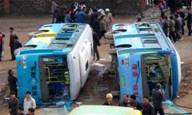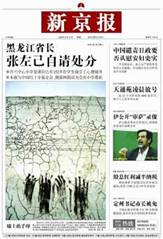New Media & Social Transformation Speech
In this
session of this conference, the other speakers represent respectively indymedia,
ZNet and Ohmynews. Those are
organizations. By contrast, I am
an individual citizen. To proceed, I must
tell you something about myself. Here are my
circumstances very briefly.
I live
most of the year in
In 2003, I
moved from the
In March
2005, for reasons that are too complicated and irrelevant to go into there, I
had to wipe out version 1.0 and begin a version 2.0 of the EastSouthWestNorth
blog. Consistent with the theme of
this session, this is my personal attempt to define and implement a project of social
transformation.
The
Consumer-Centric Approach
My premise
is consumer-centric in nature. I
placed myself in the position of an English-language-only-reading person who is
interested in finding out about China
.
What are
my principal resources?
These are easy to enumerate:
I will
remind you that these news resources decide how attitudes, perceptions and
knowledge about China
are going to be formed by English-only news consumers.
Now I
happen to also read Chinese. What
are the principal resources for a Chinese-reading person?
So I have
been reading the English-language news and the Chinese-language news on China
continuously for two years. I must say: These
are two different worlds.
How are
these two worlds different?
It is
first of all about the breadth of coverage. China
is a country with 1.3 billion people. How
much does the New York Times tell you about China
on a particular day? One or two
articles, at the most. To quote
Secondly,
it is about the limitation in space. The
New York Times reporter may be given 800 words to cover an event in
Thirdly,
it is about the attention deficit syndrome.
The western media do not have the resources, space and time to cover a
long-term, slow-developing story with multiple characters and events.
Their readers do not have that kind of patience either.
Fourthly,
and most contentiously, the western media have different emphases on what they
want to show their readers compared to what people inside China
are reading/seeing and care about. As
I said, this is contentious, and I will not elaborate any more on this point.
So EastSouthWestNorth v.2.0 is my personal attempt to bring the world of Chinese-language news to the English-only-reading world. Maybe an individual citizen cannot hope to bring all the news over. That would be far too ambitious. I never pretend that a personal blog could become the replacement of the English-language mainstream media, but my blog can supplement the English-language media.
My lesser but achievable goals are
(1) to make a difference in specific cases
(2) to create an awareness that things may be more complex than it seems.
In the following, I will show you some examples of my work:
Examples
of Work
Example
#1:
“Who is writing these headlines?”
Here is one story in
- The Standard: Most want suffrage by 2012
- South China Morning Post: Polls show public desire for democracy – and a
timetable
- Apple Daily: 65% of respondents agree with setting a time table for universal
suffrage
- Ming Pao: CUHK poll: Almost 60% accept government reform package
- Sing Tao: 60% of citizens accept government reform package
- Ta Kung Pao: 60% of citizens accept government reform package
- Wen Wei Po60% of Hong Kong people overall accept government reform package
This story was about a CUHK poll, and each newspaper gave the same data inside the stories. But their headlines were radically different, and this reflects their political positions. So the next time you glance at a headline, you have to wonder what the whole story is.
Example
#2: “Could these
reporters have been at the same event?”
At a public meeting with WTO Secretary Pierre Lamy,
Oriental Daily:

Why would some reporters not report what they saw?
Example
#3: “To make a
long story short …”

Why did the people riot in Huaxi/Huankantou?
What was the long preceding history?
What happened on that night? How
was the news reported in the Chinese media?
What information was provided by civilians to the Chinese forums?
What happened afterwards?
No, those questions are too hard for the western media
reporters to get to and for their readers to cope with.
It is easiest to show the photograph plus the usual 800-word report with
the standard comments about peasant rebellions in Chinese history, and drop the
story from view afterwards.
But you can find the sum total of virtually every significant
item in the Chinese-language for this story translated into English at
EastSouthWestNorth.
Example
#4:
“Sorry, but we’ve decided that you don’t need to know this …”
The Shalan flash flood provided an illuminating instance of
what Chinese media reporters have to cope with.
Phase 1: Flash flood killed more than 100 school children

Beijing News had this front page with the handprints of the
children desperately trying to reach up above the waterline.
Phase 2: Major discussion by
newspaper editors and reporters about the authenticity of those handprints (e.g.
Did they belong to the rescuers?)
Phase 3: Government shuts down all
coverage. A reporter’s last story
was killed, but he posted it on the Internet anyway.
Phase 4: The reporter then posted
his unpublished (and unpublishable) fields notes on the Internet as well.
This covers all the areas that he was unable to cover (e.g. Was it a
sudden rainstorm, or did someone open the floodgates at a dam upstream?
He was not permitted to go there).
All these reports have been translated from Chinese into
English at
EastSouthWestNorth. The importance of Shalan for the English-reading
public is this. This is an illustration of the development of a culture by
which media workers can talk on the internet in a passionate, intelligent and
civilized way about their work. With due respect, you never see the same
about American media workers (and I ask you to think about Judith Miller at the
New York Times and Bob Woodard at the Washington Post most recently).
Furthermore, the Chinese media workers were willing to post their unpublishable
works on the Internet. With due respect again, you never see the same from
American media workers. Here, I have to step back. Ten years ago,
this is unthinkable. Today, we have the Internet and all of this is
possible. I am personally convinced that China will have an infinitely
superior (in the ethical sense) media workers culture to the United States in ten years time (or even in
five years time).
Example
#5: “We’ve got
to cover this story, but it is far too huge …”
This is that “long-term, slow-developing story with
multiple characters and events.”
The
story about the Taishi Village election first appeared in the news in July 2005, and it is still
going on.
It has a huge number of incidents (e.g. public speeches by
citizens, a petition drive to recall the village director, constitutional
debates, public demonstrations in front of the district government office,
police arrests, senior citizens and women defending the village account books,
police raids, elections, intimidation, beatings, etc).
For the English-only world, everything changed when The Guardian reporter Benjamin Joffe-Walt filed his report when he attempted to reach Taishi village in the company of Lu Banglie. Previously, virtually nobody knows about this place. Overnight, everybody had to find out what went on there.
If the usual 800-word report was unsatisfactory, the
alternative is to google the name of the village and … lo and behold … there are the
massive files of Chinese-language source materials translated into English at
EastSouthWestNorth. The central
document was a chronology, which details what happened in Taishi over time.
The supporting documents are the various media-related stories that
spilled out of the main event.
It was this particular event that catapulted
EastSouthWestNorth to public attention. It
was less about the specific coverage of this one case.
It was more the realization from this example that there was a new form
of media out there.
Here was an event that once again shown that the mainstream
traditional media could not adequately cover a “long-term, slow-developing
story with multiple characters and events.”
But along comes a blog that was able to patiently collate multiple
sources of information (newspapers, websites, forums, etc) in different
languages and weave everything into a coherent account that was and still is
continuously updated. But I have to point out a very important -- the
blogger collates information, but is unable to verify any of it.
Metric
of Success
Has
EastSouthWestNorth been successful? I
can start off with the quantitative metric of success.
For the year 2005 up to November 15th, here are the total website
statistics:
Converted
to a daily basis, the numbers are:
The above are average numbers since the beginning of the year. My most current numbers are like 15,000 page views and 12,000 unique visitors per day. These are respectable numbers for a blog, but this is far from mass media. The New York Times gets 7 million visitors per day (or some such). I am not and probably will never be mainstream media.
But
I don’t care about numbers. I know
how to get huge numbers already (hint: post some photographs of scantily clad pretty
girls and the numbers will surge past 100,000 visitors per day in no time), and I don’t care for that. It
is the quality of that audience. At
a minimum, from the recent media attention that I am getting, this blog is
well-known among foreign correspondents based in China and may influence their
coverage. That matters much more to me.
My second
goal was to create the awareness that things may be more complex than it seems.
I should think that my regular blog visitors would agree that I am
offering a more complex picture of China.
I cannot replace mainstream media,
but I supplement them. I have even
created the awareness that blogs can outperform mainstream media in covering
certain types of stories.
As for the
larger goal of re-dressing the overall imbalance between Chinese-language and
English-language news on China, it is beyond the capability of a single citizen.
However, I seemed to have raised the awareness for this particular model.
If there are dozens or hundreds similar blogs run by individual
citizens like myself, there will be a social transformation, both in
transnational understanding and media culture.